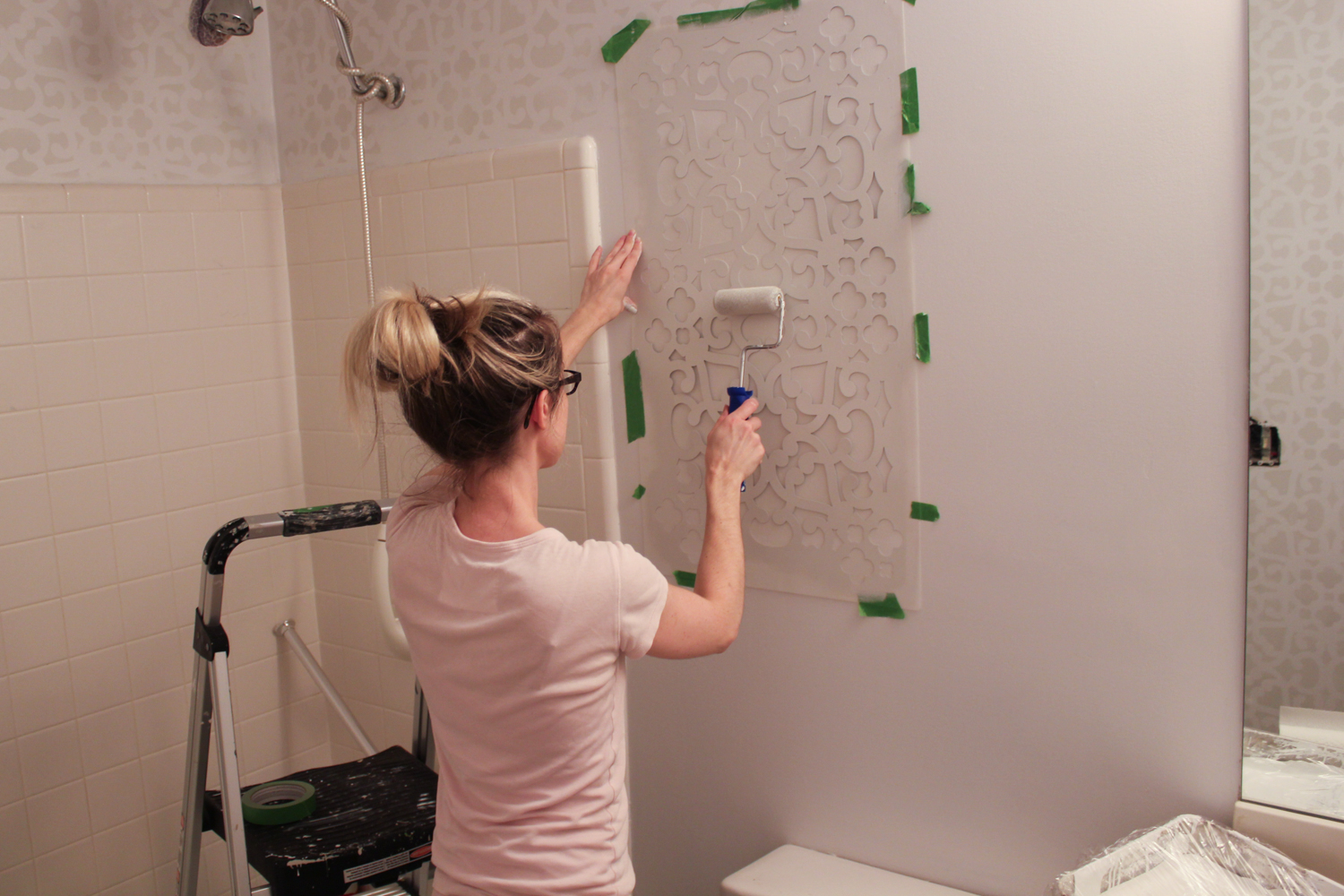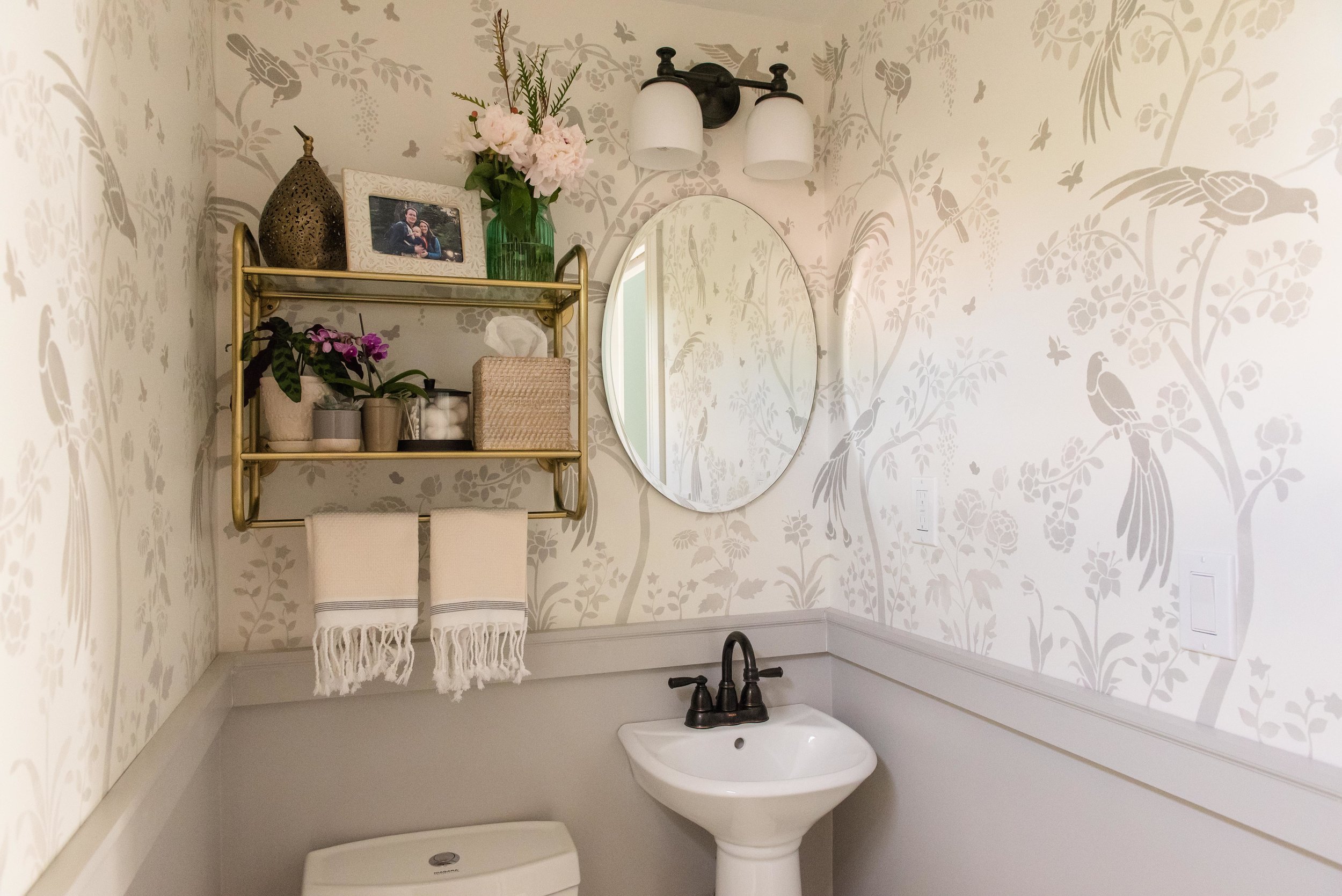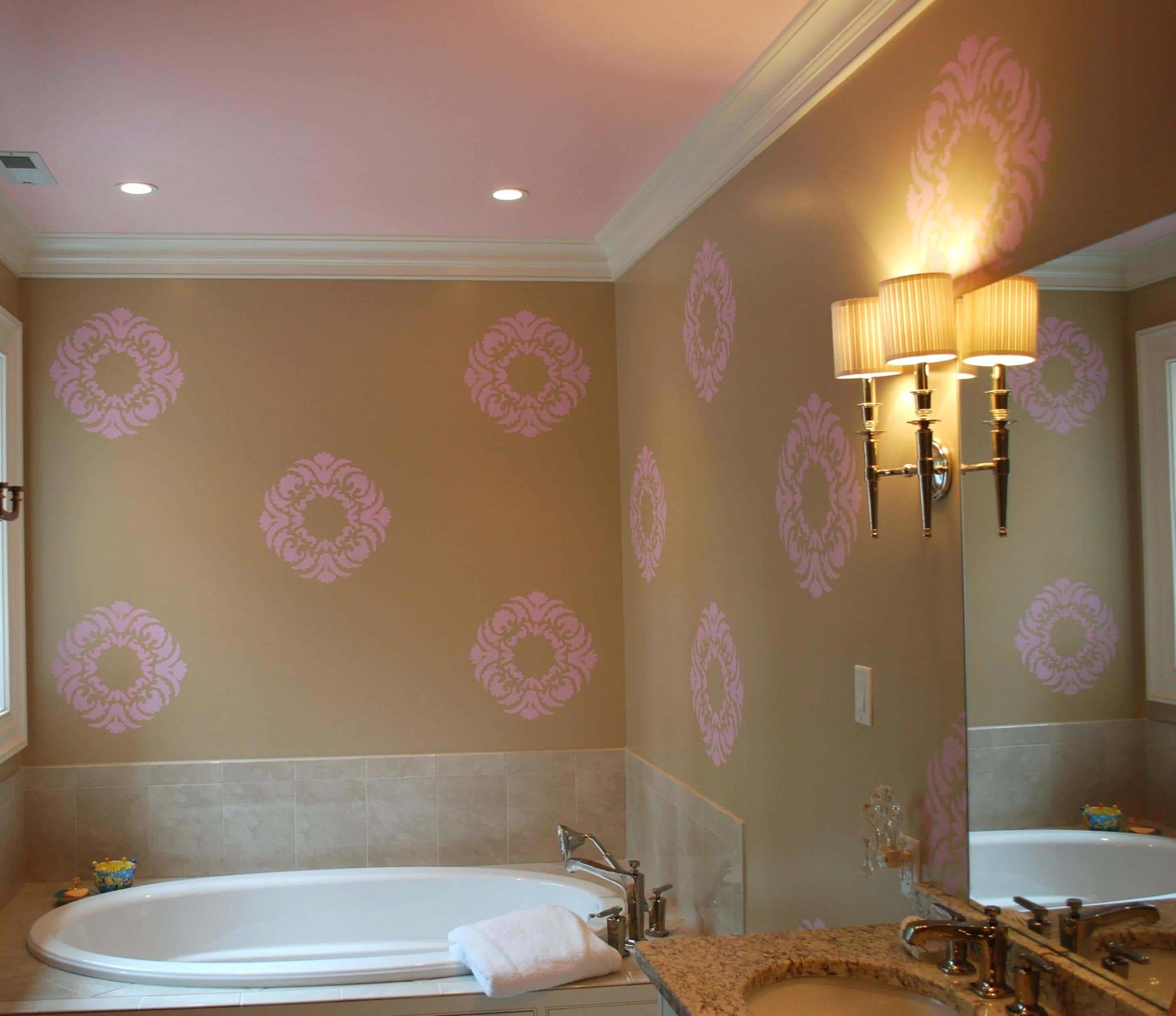Choosing the Right Stencil: Wall Stencil Ideas For Bathroom

Choosing the right stencil is crucial for achieving the desired look in your bathroom. There are many factors to consider, including the type of stencil, its size, and the design.
Types of Stencils
The type of stencil you choose will depend on your budget, the complexity of the design, and the surface you are working with.
- Reusable Stencils: These are typically made of durable materials like Mylar or plastic and can be used multiple times. They are a good option for large projects or if you plan on using the stencil for different projects in the future.
- Disposable Stencils: These are usually made of paper or vinyl and are designed for single use. They are less expensive than reusable stencils and are a good choice for smaller projects.
Stencil Sizes
Stencil sizes vary widely, so it is important to choose the right size for your bathroom space.
- Small Stencils: These are ideal for adding accents or patterns to smaller areas, such as around the mirror or on the backsplash.
- Large Stencils: These can be used to create a dramatic statement on a large wall or to cover a significant portion of the bathroom space.
Popular Bathroom Stencil Themes
- Floral: Floral stencils are a classic choice for bathrooms, adding a touch of elegance and femininity. They come in a wide variety of styles, from delicate and romantic to bold and modern.
- Geometric: Geometric stencils are a modern and sophisticated choice for bathrooms. They can create a variety of effects, from clean and minimalist to intricate and complex.
- Nautical: Nautical stencils are a fun and playful choice for bathrooms, especially those with a coastal theme. They often feature anchors, seashells, and other nautical motifs.
- Nature-Inspired: Nature-inspired stencils are a calming and relaxing choice for bathrooms. They can feature leaves, flowers, trees, or other natural elements.
Stencil Placement
The placement of your stencil is just as important as the stencil itself. Consider the following factors:
- Wall Size: A large stencil may be overwhelming in a small bathroom, while a small stencil may get lost on a large wall.
- Furniture Placement: Make sure the stencil is placed in a location that does not interfere with furniture or fixtures.
- Personal Preferences: Ultimately, the best placement for your stencil is the one that you find most pleasing.
Stenciling Techniques and Preparation

Once you’ve chosen the perfect stencil for your bathroom, it’s time to gather your supplies and get ready to transform your walls. Proper preparation is key to achieving a professional-looking finish.
Materials and Tools, Wall stencil ideas for bathroom
Having the right tools and materials on hand will make the stenciling process smoother and more enjoyable. Here’s a list of essentials:
- Stencil: The star of the show, of course! Choose a stencil made from durable material like Mylar or plastic, ensuring it’s the right size for your project.
- Paint: Select a paint specifically designed for walls, considering factors like color, finish, and durability. Water-based acrylic paints are popular choices for stenciling, as they dry quickly and are easy to clean up.
- Brushes: Use a stencil brush with stiff, angled bristles to apply paint evenly and avoid bleeding under the stencil. A small foam roller can also be helpful for larger areas.
- Sponge: A damp sponge is useful for cleaning up any paint spills or smudges.
- Masking Tape: Secure your stencil to the wall using low-tack painter’s tape. This helps prevent the stencil from shifting and ensures crisp lines.
- Cleaning Supplies: Keep a damp cloth and a cleaning solution on hand for wiping down your stencil and tools after each use.
Preparing the Wall
Before applying your stencil, it’s crucial to prepare the wall for a smooth and even finish. Here’s how:
- Clean the Wall: Remove any dirt, dust, or debris from the wall surface using a damp cloth. If the wall has any grease or grime, use a mild detergent to clean it thoroughly. Allow the wall to dry completely before proceeding.
- Sand the Wall: If your wall has any imperfections or rough patches, sand it lightly with fine-grit sandpaper. This creates a smoother surface for the stencil to adhere to and helps prevent paint from pooling.
- Prime the Wall: Apply a coat of primer to the wall, especially if it’s a new surface or has been painted recently. Primer helps the paint adhere better and provides a uniform base for the stencil.
Applying the Stencil
With your wall prepped and ready, you can begin applying the stencil:
- Position the Stencil: Carefully position the stencil on the wall where you want it to be. Use a level to ensure it’s straight and use painter’s tape to secure it in place.
- Apply the Paint: Use a stencil brush to apply paint to the stencil, working in light, even strokes. Avoid pressing too hard, as this can cause paint to bleed under the stencil. Start from the center of the stencil and work your way out to the edges.
- Remove the Stencil: Once the paint has dried slightly, carefully peel back the stencil. If you’re using multiple stencils, allow the paint to dry completely before applying the next stencil.
- Clean Up: Wipe down your stencil and tools with a damp cloth to remove any excess paint. Let the paint dry completely before admiring your new bathroom decor.
Stenciling Ideas for Different Bathroom Styles

Stencils can add a touch of personality and visual interest to your bathroom. They are a versatile decorating tool that can be used to create a variety of looks, from modern and minimalist to traditional and rustic.
Stenciling Ideas for Different Bathroom Styles
Here’s a breakdown of stencil ideas for various bathroom styles, including specific design examples and color palettes:
| Style | Stencil Ideas | Color Palette |
|---|---|---|
| Modern |
|
|
| Traditional |
|
|
| Rustic |
|
|
| Coastal |
|
|
Stenciling Ideas for Adding Texture and Dimension
Stenciling isn’t just about creating patterns, it’s about adding depth and character to your bathroom walls. Using stencils to create textured effects can transform a plain surface into something truly unique and eye-catching.
Adding texture through stencils can be a great way to create visual interest, enhance the room’s character, and even conceal minor imperfections on the wall. It allows you to explore different styles and create a personalized look that reflects your taste.
Faux Brick
Creating a faux brick wall effect with a stencil is a great way to add a rustic charm to your bathroom. You can achieve a realistic look by using a brick pattern stencil and multiple paint colors to create depth and dimension.
- Choose your brick stencil: Select a stencil with a realistic brick pattern, considering the size and shape of the bricks you want to emulate.
- Prepare the wall: Clean and prime the wall surface to ensure a smooth and even base for the stencil.
- Choose your paint colors: Opt for two or three shades of the same color family to create a natural brick effect. For example, you could use light brown, medium brown, and dark brown.
- Apply the first layer: Using the lightest shade, apply a thin coat of paint to the entire wall surface. Allow it to dry completely.
- Stencil the brick pattern: Secure the stencil onto the wall using painter’s tape. Apply the medium shade of paint through the stencil, being careful not to overload the brush.
- Add depth with the darkest shade: Use the darkest shade to highlight the edges and recesses of the brick pattern. Apply it sparingly, focusing on areas where shadows would naturally occur.
- Repeat the process: Continue applying the stencil and layering the paint colors until you achieve the desired brick effect.
Faux Tile
If you’re looking for a more modern and clean look, a faux tile effect can be achieved using a tile pattern stencil and different shades of the same color. This technique can create the illusion of a tiled wall without the hassle of actual tiling.
- Choose your tile stencil: Select a stencil with a tile pattern that complements your bathroom’s style. Consider the size and shape of the tiles you want to emulate.
- Prepare the wall: Clean and prime the wall surface to ensure a smooth and even base for the stencil.
- Choose your paint colors: Opt for two or three shades of the same color family to create a subtle variation in the tile pattern. For example, you could use light gray, medium gray, and dark gray.
- Apply the base color: Using the lightest shade, apply a thin coat of paint to the entire wall surface. Allow it to dry completely.
- Stencil the tile pattern: Secure the stencil onto the wall using painter’s tape. Apply the medium shade of paint through the stencil, being careful not to overload the brush.
- Add depth with the darkest shade: Use the darkest shade to highlight the grout lines between the tiles. Apply it sparingly, focusing on the edges of the tile pattern.
- Repeat the process: Continue applying the stencil and layering the paint colors until you achieve the desired tile effect.
Embossed Patterns
Embossed patterns add a tactile element to your bathroom walls, creating a unique and visually appealing effect. To create embossed patterns, you’ll need a stencil and a textured paint or paste.
- Choose your stencil: Select a stencil with a pattern that complements your bathroom’s style. Consider the size and detail of the design you want to create.
- Prepare the wall: Clean and prime the wall surface to ensure a smooth and even base for the stencil.
- Choose your textured paint or paste: Opt for a textured paint or paste that matches the desired effect. You can find a variety of options, including those with a rough, smooth, or patterned texture.
- Apply the textured paint or paste: Secure the stencil onto the wall using painter’s tape. Apply the textured paint or paste through the stencil using a brush or a trowel.
- Remove the stencil: Carefully peel back the stencil after applying the textured paint or paste.
- Allow to dry: Allow the textured paint or paste to dry completely before proceeding to the next step.
- Paint the embossed pattern: If desired, you can paint the embossed pattern with a contrasting color to highlight the design.
Stenciling Ideas for Personalizing Your Bathroom

Your bathroom is a personal space, so why not make it reflect your unique style? Stenciling is a fantastic way to add a touch of individuality and personality to your bathroom decor. From incorporating your favorite colors and patterns to creating unique accents, the possibilities are endless.
Personalized Stencil Designs
Adding personalized touches to your bathroom can make it feel more like home. You can achieve this by incorporating your initials, favorite quotes, or family crests into your stencil designs.
“Stencils can be a fantastic way to create a personalized and unique space that reflects your individual style.”
Here are some ideas for personalized stencil designs:
- Initials: Stencil your initials on a bathroom towel rack, a soap dispenser, or even a mirror frame.
- Quotes: Choose a quote that inspires you and stencil it onto a bathroom wall or a vanity mirror. Some popular bathroom quotes include: “Live, Laugh, Love”, “Find Your Happy Place”, and “Embrace the Day”.
- Family Crests: If you have a family crest, stencil it onto a bathroom wall, a decorative storage bin, or a framed piece of wall art.
Unique Bathroom Accents with Stencils
Stencils can be used to create a variety of unique and personalized bathroom accents. Here are a few ideas:
- Wall Art: Stencil framed wall art pieces featuring inspirational quotes, botanical motifs, or abstract designs. You can create a gallery wall of stenciled art pieces or simply add a single piece as a focal point. For example, you could stencil a botanical motif on a canvas and frame it for a natural and elegant touch.
- Decorative Storage Bins: Stencil storage bins for toiletries, towels, or other bathroom essentials. Choose a design that complements your bathroom decor. For instance, you could stencil a geometric pattern onto a storage bin for a modern look, or a floral motif for a more traditional style.
- Mirror Frames: Stencil decorative frames around bathroom mirrors. Use a stencil to create a simple border, or get creative with a more intricate design. For example, you could stencil a geometric pattern or a floral motif around the mirror for a unique and eye-catching look.
